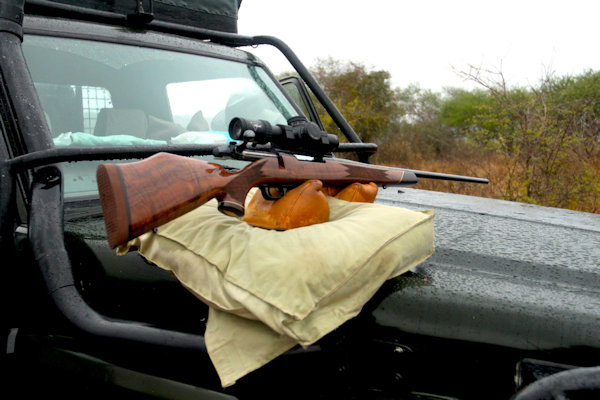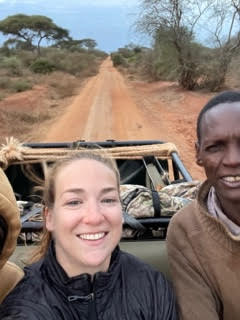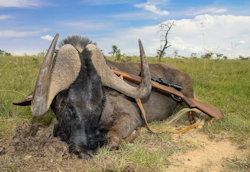SEJournal Online is the digital news magazine of the Society of Environmental Journalists. Learn more about SEJournal Online, including submission, subscription and advertising information.
 |
 |
| Trophy hunting generates hundreds of millions of dollars in revenue across Africa annually, often in places like the Central African Republic, Burkina Faso and Chad that see relatively few photographic tourists. Photo: Rachel Nuwer, courtesy bioGraphic. |
FEJ StoryLog: Neither Pandemic Nor Politics Derailed Grantee’s Trophy Hunting Story
By Rachel Nuwer
In 2018, I was having lunch with a longtime source when he mentioned a “secret meeting” of scientists and conservationists that he had just come from in Johannesburg. The subject of the meeting was the decline of the trophy hunting industry and, surprisingly, how big a threat that decline poses to African conservation efforts.
Trophy hunting foots the bill for about two-thirds of Africa’s protected areas — news to me at the time — so hunting bans and fewer hunters, in general, means less or even no money for conserving and managing huge swaths of nature across the continent.
My source and his colleagues had convened the meeting to figure out the scope of the problem and what to do about it. But they’d had to do so in secret because it’s virtually impossible to have a sensible conversation about trophy hunting in Africa.
The issue is mired in misinformation, emotion and politics, with (mostly Western) celebrities and media quick to jump on the anti-trophy bandwagon alongside thousands of social media armchair warriors. Some nonprofit conservation groups go so far as to forbid their experts from even speaking publicly about trophy hunting for fear of blowback from donors.
All the shouting and silencing
are ultimately counterproductive
for conservation, including for the
very species that people who oppose
trophy hunting wish to protect.
All the shouting and silencing are ultimately counterproductive for conservation, though, including for the very species that people who oppose trophy hunting wish to protect.
My source urged me to write a story that sheds light on the gravity of this problem, and I agreed. At the time, I had no idea that I was signing up for a 4 ½-year odyssey that would become one of the most trying of my career.
Embedding with conservation-first hunters
It took me about a year of pre-reporting and pitching before I landed a feature assignment with a major U.S.-based magazine and also secured a grant from the Society of Environmental Journalists’ Fund for Environmental Journalism that would enable me to conduct field reporting in Tanzania.
 |
| The author and a game skinner prepare to depart camp for a trip around the Ruvu Masai hunting block. Photo: Courtesy Rachel Nuwer. |
I was making plans for that reporting when the pandemic arrived. Citing the unknown timeline, the magazine’s editor-in-chief moved to kill the story in summer 2020, but after several emails and phone calls with my editor I succeeded in talking them into sticking with it.
My plan was to spend a few days in the bush with a professional hunting group and one of their clients. Finding the right professional hunter was a bit challenging. I wanted someone in a populous country that illustrated the difficulties of conserving wildlife alongside high human densities, so that immediately ruled out Namibia. Like any industry, there’s also a great deal of variability in the quality of groups that operate, and I needed to embed with one that puts conservation first.
I drew upon my connections in the African conservation world to identify a few strong candidates and then approached them. At first, most were understandably wary of me because I was a Western journalist — just the sort of person they were used to being burned by. But after several calls in which I explained who I was and what I was trying to do, all came around.
I eventually settled on the Tanzanian group I profiled in the story because of their stellar reputation and conservation record, and also because one of their clients was willing to have me join him and his family on their vacation.
Long days at the bush camp
In July 2021, I finally got to go spend a couple weeks in Tanzania. It felt great to be back out in the world reporting after more than a year being grounded by the pandemic, even if the field work was pretty physically and mentally demanding.
Days at the bush camp started at 5:30 a.m. and ended around 11 p.m.; I shared a small tent with a roommate who was very vocal about her different political views from mine (and who was suffering from a bad cold); and I had to figure out tricky logistics for getting three separate COVID-19 tests while in Tanzania.
These were minor issues, though, and the experience ultimately reinvigorated my commitment to reporting complex stories from the field.
Unfortunately, though, it turned out that the most challenging part of the assignment was still ahead of me.
I was slightly concerned when my feature draft was assigned to a newer editor who didn’t have a background in science or conservation. But things seemed to go well and, after a few rounds of edits, the editor told me that they were likely going to run the story for print in addition to the web. This was great news, not only because it would have meant getting a higher fee, but also because I knew the story would reach more readers this way.
I received a startling email
from my editor: Some of her
colleagues were not happy
with the story’s message.
As we were approaching the publication date, however, I received a startling email from my editor: Some of her colleagues were not happy with the story’s message. This was completely unexpected because the draft I’d written very closely followed my original pitch, and up until then my editor’s feedback had been positive.
I was not comfortable with the direction they would have required me taking the story in order to make it work for them, so in the end they killed it and we parted ways.
Homeless story, sleepless nights
 |
| The black wildebeest is one of many species sought by trophy hunters across Africa. Hunting conservancies, like the one where this animal was killed, account for approximately two-thirds of all of sub-Saharan Africa’s protected areas. Photo: Okyela, courtesy bioGraphic. |
This left me with a homeless 7,000-word feature on a highly controversial topic — not exactly an easy re-pitch. But at this point I cared far too much about the story and had sunk way too much time and energy into it to give up. I also had a contractual obligation to FEJ to produce something in return for the reporting funds I’d been given.
So I spent the next six months trying to find the story a new home, and missing quite a bit of sleep from stress as a result. Unsurprisingly, several editors rejected the story not because they didn’t think it was important or legitimate, but because the subject matter was too unpalatable.
My luck finally changed when I reached out to Steven Bedard, my editor at bioGraphic. Steven was also concerned about how readers would react, but he understood, too, that the story delivered an important, science-based message that people needed to hear.
To my great relief, he and his colleagues decided to move forward. Edits went well and primarily consisted of doing a bit of rearranging and strengthening some of the science and history sections. I’m confident these changes made the piece better in the end.
After publication I received my
first-ever death threats on Twitter,
but I also received quite a few
messages commending the story.
After publication I received my first-ever death threats on Twitter, but I also received quite a few messages from scientists, conservationists and others commending the story. A friend even told me that her mother sent her a link to the story as a must-read, unaware that she knew the author.
I consider the trophy hunting story to be one of my best clips to date, but it definitely took a toll at times on my mental health. The struggle to get it published also left me feeling more cynical about science journalism in general.
It was disappointing (though not surprising) to see that media outlets, just like conservation experts, are subject to silencing for fear of triggering the social media mob — or simply because it’s easier not to talk about difficult, unpopular subjects.
I became a journalist in order to tell complex, nuanced and sometimes challenging stories, though, and I’m sticking with that goal as long as I can afford to as a freelancer.
[Editor’s Note: Read Nuwer’s story, “Africa’s Conservation Conundrum,” at bioGraphic.]
Rachel Nuwer is a freelance science journalist who regularly contributes to The New York Times, Scientific American, National Geographic, Nature and more. Her first book, “Poached: Inside the Dark World of Wildlife Trafficking” (Da Capo, 2018), took her to a dozen countries to investigate the multibillion-dollar illegal wildlife trade. She wrote about reporting that beat for a 2018 SEJournal Inside Story Q&A, based on her SEJ beat reporting award. Her second book, “I Feel Love: MDMA and the Quest for Connection in a Fractured World” (Bloomsbury, 2023), tells the story of the science, history, politics and culture of the drug MDMA (aka ecstasy or molly). She lives in Brooklyn.
* From the weekly news magazine SEJournal Online, Vol. 9, No. 2. Content from each new issue of SEJournal Online is available to the public via the SEJournal Online main page. Subscribe to the e-newsletter here. And see past issues of the SEJournal archived here.











 Advertisement
Advertisement 



